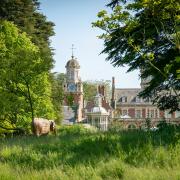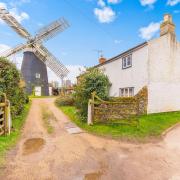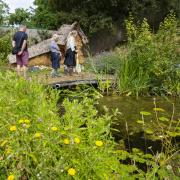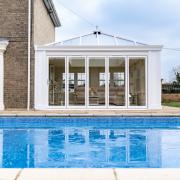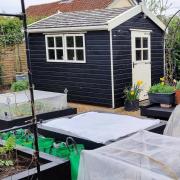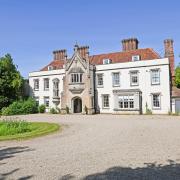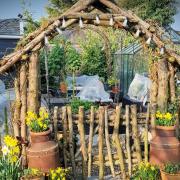This year marks the 37th Hidden Gardens of Bury, now the highlight of the town calendar and growing more and more popular each year. In 2022 a record £24,699 was raised.
'It’s lovely to have repeat gardens as well as new, and they range from the very large gardens like the former hospice, home of Mary Kent, to hidden courtyards of which there will be a new one this year near the Abbey Gardens,' says George Chilvers, community fundraising Manager at St Nicholas Hospice. 'They show people just what can be done in a tiny area and visitors are inspired by what they discover behind doors and walls.'
Most of the gardens are in the historic town centre with a few further afield and well worth a few minutes’ walk. The event makes a wonderful day out with refreshments available in several of the gardens, as well as live entertainment and a whole selection of produce and plants to buy.
It’s all hands to the pump with a whole team of volunteers, supporters and generous gardens willing to share their private spaces for such a worthy cause. An additional ‘Celebrate your Gardens’ event began in June and continues until July 31, with a variety of online talks and tours in and around Bury St Edmunds. The theme this year is how to encourage wildlife into our gardens.
The Hidden Gardens of Bury are open to visitors 11am-5pm on Sunday July 2. Tickets cost £7 (free for under-16s), available online or from 10.30am on the day of the event at St Nic’s gazebo on Angel Hill. A programme and map are part of the ticket.
Find out more at hiddengardens.co.uk

Caring and sharing with plants
As a specialist palliative care nurse for almost 20 years, Siobhan Richardson knows only too well what plants can mean for the wellbeing of people with life-limiting illnesses. But since the pandemic lockdown, a new direction beckoned and she’s been gardening full-time for the past two years, at one point looking after 27 gardens, although that’s now down to six or seven.
'I worked from having a clinical case load to a gardening case load,' she says cheerfully. 'At the hospice, I did five years on the ward and almost 15 years in the community. I’m very privileged to have done that.' Her aim in the 'hidden' garden behind Greene & Greene solicitors, is to make the space a joy to enter for clients, and for the staff to walk through from one part of the building to another. Not a space where people come out to put their feet up, but to provide colour and interest through the seasons.

'And because everyone is working 12 months of the year, we’re just trying to ensure that there’s a little bit of something all the time,' says Siobhan. 'A gentleman said only this morning, "Oh my goodness, I wasn’t expecting this!"' This will be the third year that Siobhan is helping with Hidden Gardens. Taking over from the previous gardener, she has slowly removed tired shrubs and a massive pampas grass to make space for some evergreen planting for the winter months and 'just to introduce various bits of colour, but you have to get to know the rhythm don’t you?'
She’s overjoyed at the ancient and beautiful walls being reinstated, giving the chance to make the most of climbers such as hydrangea, fragrant trachelospermum and lovely espaliers of cotoneaster and pyracantha. Husband Clyde has been helping out by attaching wire to the walls as a framework for the climbing plants. 'He’s up a ladder very often here,' she says. 'Without his help, a lot of this wouldn’t happen. It wasn’t part of the masterplan but it’s working well!'
The soil is chalky - 'not so bad with soil improver' - and plants range from a magnificent display of bright tulips and brunnera in late spring, to bearded irises, then peonies, salvias, delphiniums and classic roses such as Gloire de Dijon. There’s a place for Macleaya cordata, the plume poppy, and clumps of oriental poppies too, as well as various grasses and some showy dahlias later on.
'Quite random but why not?' says Siobhan, who confesses to a love of naturalistic planting. 'If it doesn’t take so well, it’s not the end of the world. The thing about working in palliative care is, you can think, does it really matter? Am I going to get too stressed about this? I now worry about things in a different way, having that perspective.'
She shows me her favourite part of the building where an arch has been skilfully rebuilt and, together with Clyde, they carefully removed the ivy from the old flint wall to make space for the roses ‘Golden Showers’ and ‘Casino’, both yellow. 'It will be more welcoming for people coming in from Guildhall Street.' No corner is neglected and there are five entrances to consider, one in deep shade under a massive holm oak where a second cotinus, the smoke bush, so far appears to be thriving.
'I do feel that I’m literally a custodian and didn’t come in guns blazing. Somebody has put a lot of time and effort into this and I’ll see if I can help nurture it or experiment with it somewhere else but I try not to throw anything away. And I do love coming here. Clients are walking through and they might just stop and say ‘Ahh, this has really cheered me up,’ so it’s worth it isn’t it?' There’s even a tiny garden shed to house the garden tools, a time-worn space which brings out Siobhan’s strong creative side.
'I have flights of fancy in here. Not quite lady of the manor but I’m in the medieval grid so I’m one of the servants aren’t I? I love the independence of working in the garden and being left to get on with it. Eureka!'

'Hidden Gardens inspired our house move'
The Hidden Gardens of Bury was the very reason that Dr Steve Jones and his wife Philippa moved into the town. They were living near Cambridge where Steve was a research engineer and their garden was so huge it took three days to mow the lawn. 'We didn’t know Bury at all,' says Steve. 'Then we came to look at Hidden Gardens and thought what a lovely town.' Swapping their labour-intensive garden for a tiny courtyard in Church Walks, which they now open for Hidden Gardens, was a good choice, says Steve.
'We had reached 70 and we both had bad backs so this is ideal as we can go to the Abbey Gardens and watch other people do the weeding. Great fun!' One of the first things they did when they moved five years ago was to clear some rubbish in one corner to discover a leaden-like toad, (as you do). 'Warty was in the corner buried, just neglected poor thing,' says Steve. 'So we resurrected him and he’s quite happy now.' Warty is named after the toad in a 1920s book by New York columnist Don Marquis and now has his own narrative, having been adopted by the couple as a permanent fixture.
'The garden is the domain of a large, self satisfied toad, Mr Warty Bliggens,' says Steve. But of course it is much more than that with evergreen shrubs, intertwined with colourful climbers such as passion flower and clematis, and potted annuals providing a pleasing backdrop to what Steve calls his steel work. He’s also created some impressive bronze sculptures, including a series of what turned out to be 'grumpy old men' during lockdown.

'I thought I’d make some happy ones but they were dead creepy,' he laughs. Then there’s a series of intersecting poems he describes as a word maze. It’s the sort of challenge he clearly enjoys. In a corner is a series of ornamental steel stakes which would look good in any garden. They’ll be for sale on the day to raise funds for the hospice.
'I think we raised about £1,600 last year, just in Church Walks,' says Steve. 'On the day, the street is full of stalls selling plants, jigsaws, flower arrangements, books, marmalade and jam. Absolute bedlam, but a lot of fun.' Philippa contributes with her jam-making and sits outside on the day to welcome visitors in. 'We try to get them going round in a circle but they tend to go free range,' he laughs. Inevitably you get people meeting up saying, "Oh I haven’t seen you for ages!"'
Church Walks is a narrow lane with an intriguing dogleg where a communal garden offers spectacular views over the rooftops to the cathedral and the Norman Tower. It’s here that Steve mentions in passing his latest work, a 64kg crown of thorns made of gold-plated stainless steel and gifted to the cathedral. It was on display above the nave altar during the Lent season earlier this year. It seems the Joneses have well and truly settled in.

Herbal delights
A landmark building in Bury St Edmunds with its own hidden herb garden is the Guildhall, thought to date back to the late 11th century as part of the medieval plan for the town. On the approach to the enclosed herb garden behind the building, visitors can enjoy a colourful herbaceous border with roses climbing the historic flint walls. Once through the door into the old courtyard, they will encounter a series of raised beds created by herbalist Sue Thompson, each herb with a story and a place in history.
The garden is tended by Sue, well-known for her ability to bring history to life, and here visitors can enjoy sensory beds representing sight, taste, touch and scent. There’s a timeline of medicinal herbs - a particular area of Sue’s expertise - as visitors will discover on the day. They will also have a chance to experience the Tudor kitchen of the Guildhall where a café will be run by St Nicholas Hospice.

Surprise behind the gates
For over 25 years, Isobel was joint organiser of the Hidden Gardens of Bury and her beautiful garden is one of the most 'hidden' among the 30 or so gardens opening on July 2.
Along narrow College Lane in the heart of historic Bury, where you can hear the bells of St Mary and the cathedral, a large walnut tree is now a magnificent distraction from a 1960s BT building on one side. A superb sunken area lined with granite sets was the creation of Ted Ashton, who died in 2016, a feature that sets off a multitude of classic roses and clematis.
'I’m learning to be more relaxed, especially with the roses,' says Isobel. 'Last year the climbing roses did reasonably well, even though later flowers suffered in the heat, but there was a new flush in late July.' Like so many gardeners, Isobel Ashton has lost plants over the year due to the extremes of weather. But, dedicated plantswoman that she is, if changes are needed, she will simply get on with it. She lost three Salvia ‘Amistad’ in the heat and Salvia guarantica, which she had enjoyed for 20 years, 'I suspect from the cold'. But, on the bright side, a much-loved fuchsia, going back to when the Ashtons arrived 36 years ago, appears to have risen from the dead 'now sprouting wonderfully from the ground'.

A Japanese maple has been transformed after the 2021 heatwave with new growth and Isobel is looking forward to a dazzling red display in autumn. She’s also making deliberate changes, removing two large phormiums which had outgrown their space, replacing them with two pink and green Phormium ‘Jester’ to give other plants a chance and to pick up nearby colours.
The small greenhouse has gone, providing another opportunity, says Isobel, 'as yet undecided'. That’s the joy of gardening, always something new to look forward to.

Hedgehogs welcome!
Kate Osborne and George Grayland at Westley Road have been busy ticking boxes when it comes to caring for wildlife, except that the job is never done as Kate is keen to provide for precious pollinators in all seasons.
Hedgehogs are always welcome when they need a safe feeding station, arriving from adjoining amenity land where they tend to nest. Kate mentions two regular visitors and she’s hoping for babies. Nothing upsets her more than careless use of garden strimmers or finding dead or injured hedgehogs in the road.
A stone tablet by the wildlife 'dipping pool', with easy access for frogs and friends, quotes Gerald Manley Hopkins from his poem Inversnaid which ends: 'Long live the weeds and the wilderness yet'. An arch intertwined with clematis and dog rose leads you in. And if your idea of weeds is dead-nettle growing in the grass, for Kate and George it’s a boon for bees. Forsythia in a wildlife corridor was replaced by Cercis siliquastrum, the Judas tree, of more use to pollinators.
'It’s the first bit of the garden to get the sun in the morning so we wanted to plant things for the bees when they come out hungry and want to warm up,' says Kate. Visitors on a return visit to this wildlife haven will also be able to enjoy other new additions. And rather than doing the more traditional teas and cake on the day, there will be George’s Gelato, a home-made ice cream with flavours such as roast banana with peanuts and salted caramel. The bonus is, you can learn about how to care for wildlife in your own garden.

Space to wander
When Mary and John Kent bought the house that provided the first hospice care in Bury in 1992, one of the first things they did was the Hidden Gardens tour. Together they worked on the enormous garden - 'John the gardener, me the helper,' says Mary - even extending the planting into the former ambulance park.
In 1995, Mary said to John: 'If people with little courtyard gardens can actually let people through their house to look at their garden, it would be criminal not to open ours.' Together they opened the garden for at least 25 years, until Covid allowed only virtual visits. After losing John in 2021, Mary gallantly continued to open her beautiful garden and plans to do so again this year. Visitors will be able to admire the many trees and colourful planting, as well as the pergola and paths done by John over a two-year period.




